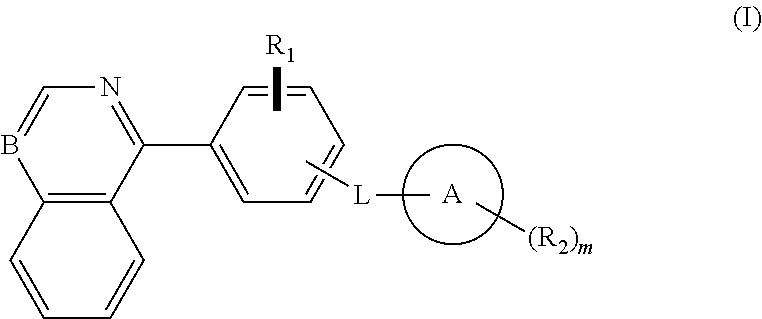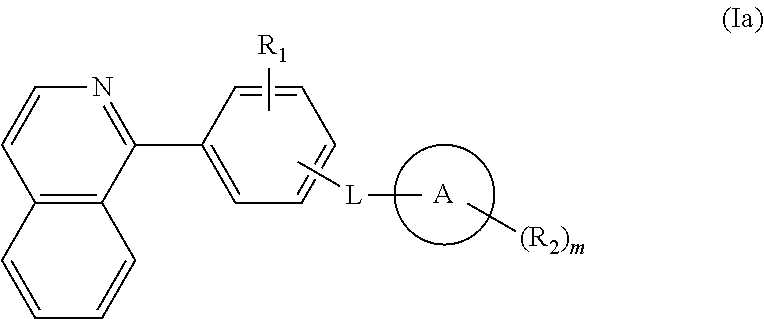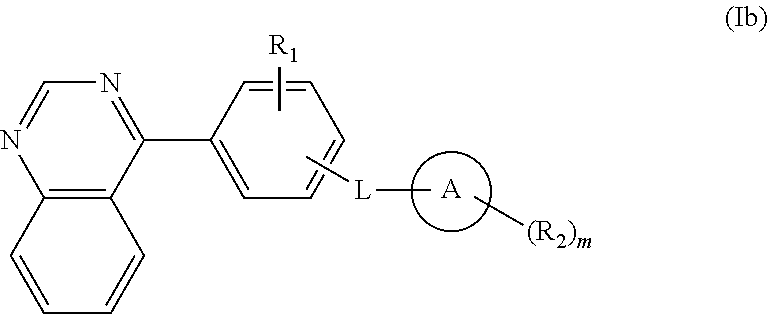Isoquinoline, quinoline, and quinazoline derivatives as inhibitors of hedgehog signaling
a technology of hedgehog signaling and derivatives, which is applied in the direction of heterocyclic compound active ingredients, biocides, drug compositions, etc., can solve the problem that the blockade of gli-based transcription has not yet been shown to arrest bcc growth
- Summary
- Abstract
- Description
- Claims
- Application Information
AI Technical Summary
Benefits of technology
Problems solved by technology
Method used
Image
Examples
example 1
[0146]
[0147]A solution of 2-chloro-5-nitrobenzoyl chloride (11.70 g, 53.2 mmol) in DCM (66.0 mL) was added dropwise to a solution of 2-amino-1-phenylethanol (7.30 g, 53.2 mmol) in DCM (200 mL) containing triethylamine (7.40 mL, 53.2 mmol) at 0° C. The reaction mixture was stirred at 0° C. for 1 hr. The reaction was quenched with saturated NaHCO3 solution and the organic layer was separated. The organic layer was washed with brine, dried over anhydrous Na2SO4 and then concentrated under reduced pressure. The crude residue was recrystallized from hexane / EtOAc to yield the desired compound (10.76 g, % yield) as a white solid. 1H NMR (400 MHz, CDCl3): δ 8.46 (d, J=2.8 Hz, 1H), 8.21 (dd, J=2.8, 8.8 Hz, 1H), 7.59 (d, J=8.8 Hz, 1H), 7.44-7.31 (m, 5H), 6.65 (br s, 1H), 5.01 (m, 1H), 3.97 (m, 1H), 3.56 (m 1H), 2.68 (d, J=2.8 Hz, 1H). MS (ESI): Calcd. for C15H13ClN2O4Na 343. found 343 (M+Na)+.
example 2
[0148]
[0149]A mixture of 2-chloro-N-(2-hydroxy-2-phenylethyl)-5-nitrobenzamide (3.40 g, 10.60 mmol) with POCl3 (11.86 mL, 127.2 mmol) and P2O5 (17.0 g, 119.8 mmol) in toluene / xylene (265.0 mL, 1:1) was refluxed for 2 d. The reaction mixture was cooled down and then poured into ice-water followed by neutralization with 10% NaOH solution. The mixture was extracted with EtOAc and the combined extracts were washed with brine, dried over anhydrous Na2SO4 and then concentrated under reduced pressure. The residue was purified by flash column chromatography on silica gel (hexane / EtOAc 95:5 to 90:10) followed by recrystallization from hexane / EtOAc to yield the desired compound (850 mg, 28%) as yellow crystals. 1H NMR (400 MHz, CDCl3): δ 8.66 (d, J=5.6 Hz, 1H), 8.38 (d, J=2.8 Hz, 1H), 8.32 (dd, J=2.8, 8.8 Hz, 1H), 7.95 (m, 1H), 7.80 (d, J=5.6 Hz, 1H), 7.77-7.73 (m, 2H), 7.57 (m, 2H). MS (ESI): Calcd. for C15H10ClN2O2: 285. found 285 (M+H)+.
example 3
[0150]
[0151]A mixture of 21-(2-chloro-5-nitrophenyl)isoquinoline (785 mg, 2.76 mmol) and tin (II) chloride dehydrate (2.93 g, 12.97 mmol) in ethanol (36.8 mL) was heated at 70° C. for 1.5 hr. The reaction mixture was cooled down and then poured into ice-water followed by neutralization with saturated NaHCO3 solution. The mixture was filtered through a pad of celite and washed with EtOAc. The filtrate was extracted with EtOAc and the combined extracts were washed with brine, dried over anhydrous Na2SO4 and then concentrated under reduced pressure to yield the desired compound (650 mg, 92%) as yellow solid. 1H NMR (400 MHz, CDCl3): δ 8.61 (d, J=5.6 Hz, 1H), 7.88 (d, J=8.0 Hz, 1H), 7.75-7.67 (m, 3H), 7.53 (m, 1H), 7.29 (dd, J=0.8, 8.0 Hz, 1H), 6.76 (m, 2H), 3.76 (br s, 2H). MS (ESI): Calcd. for C15H12ClN2: 255. found 255 (M+H)+.
PUM
| Property | Measurement | Unit |
|---|---|---|
| temperature | aaaaa | aaaaa |
| temperatures | aaaaa | aaaaa |
| temperature | aaaaa | aaaaa |
Abstract
Description
Claims
Application Information
 Login to View More
Login to View More - R&D
- Intellectual Property
- Life Sciences
- Materials
- Tech Scout
- Unparalleled Data Quality
- Higher Quality Content
- 60% Fewer Hallucinations
Browse by: Latest US Patents, China's latest patents, Technical Efficacy Thesaurus, Application Domain, Technology Topic, Popular Technical Reports.
© 2025 PatSnap. All rights reserved.Legal|Privacy policy|Modern Slavery Act Transparency Statement|Sitemap|About US| Contact US: help@patsnap.com



